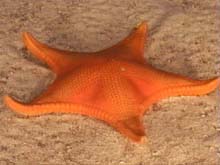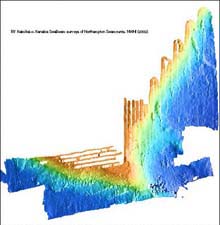
A bright orange sea star (Pseudarchaster myobrachius) seen at Northampton. Click image for larger view.
Exploring Northampton Seamounts
September 17, 2002
Frank Parrish, Fisheries Biologist
National Marine Fisheries Service
The seamounts are a pair of forgotten peaks in the middle of the Northwestern Hawaiian Islands, and we do not know what we will find there. Recent satellite tag data show that a few monk seals from Laysan Island, about 40 miles to the north, frequently visit these seamounts, but these seals are probably the only divers to have explored the seamounts. Scientists are about to visit this area to see if they can determine what keeps the seals coming back. They may find fields of sand devoid of biota, or lush beds of precious coral that are home to eels and other monk seal prey.
Monk seals are Hawai'i's oldest explorers. For more than a million years, this species has navigated the deep waters of the archipelago. They are the experts on the submarine geography of the Northwestern Hawaiian Islands. Capable of swimming hundreds of miles, these seals leave the protection of their islands and travel to neighboring banks, searching the deep slopes for food. With only a few breaths to sustain them for 30 minutes, a seal can explore more of the bottom than a team of scientists working all day in a submersible. Routinely diving with ease to 300 ft, and capable of probing subphotic depths down to 1,500 ft, these seals have an enviable knowledge of the deep slopes. Older seals likely have searched much of the summits and have found the best places to eat. These sites are the seals' favorites, and they frequent them in the same manner that we revisit our favorite deli.

Seabeam map of the south and east banks of the eastern Northampton Seamount. This covers approximately 15 square miles and took John Smith about 18 hours to generate. It would have taken much longer if we didn't have such good weather that enabled the ship to map at high speed. Click image for larger view.
Scientists are beginning to find these sites by tagging the seals with transmitters and video cameras, documenting the seals' travels. Once an intriguing site is revealed, scientists explore it using divers or submersibles. So far, this type of work has been limited to the French Frigate Shoals Region, which is southeast of the Northampton Seamounts. Some of the seals' favorite places include sand fields, where the seals chase down and feed on flatfish; areas with pizza-pan-shaped rocks, where octopuses hide; and fields of whip corals that the seals raid at night to feed on eels. Recent exploration of a couple of subphotic sites discovered beds of precious coral, which may harbor eels and other prey. The coral "trees" in the bed ranged from being 1-ft tall plates to 6-in gold fans. Not all sites that the seals frequent are food-rich, however. Some sites contain submerged caves, where the seals rest in between feeding bouts.
By exploring the Northampton Seamounts, we are extending the investigation of monk seal foraging habitats into remote areas of the archipelago. We are fortunate to have the use of a vessel equipped with an acoustic mapper, a remotely operated vehicle (ROV), and a submersible. Using these tools, we can focus our efforts on the seals' deep feeding range, working at depths between 1,000 and 1,500 ft. First, we will map the area to identify possible dive sites. Then, we will explore them ourselves using either the ROV or the submersible. On all dives, we will survey and record fish species and size, and habitat. If we find beds of precious coral, we will document their composition and size. Finally, the biologists will be looking for new species.
Sign up for the Ocean Explorer E-mail Update List.




















